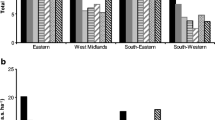Abstract
Residential use of pesticides has increased substantially in the United States over the past twenty years. Contact with pesticide-treated turf may result in dermal exposures, particularly among children. This study evaluated wipe sampling and foliar wash techniques to measure chlorpyrifos on turf following insecticidal treatments with Dursban 4E™. Residues of the fluorescent tracer Uvitex OB™ were also measured as part of a larger study adapting video imaging analysis to children's exposure to pesticides. The wipe technique recovered an average of 0.50 μg/cm2 of chlorpyrifos, or 1.5% of the initial deposit, and an average of 0.21 μg/cm2 of tracer, or 6.1% of the initial deposit, from bluegrass turf 1–3 hours after application. The foliar wash technique recovered significantly more chlorpyrifos and tracer (1.3 μg/cm2, or 4.0% and 0.36 μg/cm2, or 10.5%, respectively). The resulting chlorpyrifos/tracer ratio was also significantly greater for the foliar wash technique (4.6) than for the wipe sampling technique (2.6). Variability associated with each technique was similar. Chlorpyrifos dissipation on irrigated and non-irrigated plots was evaluated through collection of wipe and foliar wash samples at six time intervals over a 48 h period. Wipe technique results indicated that irrigated residues were significantly lower than non-irrigated during the first 6.5 h post-application; foliar wash residues were significantly lower on the irrigated plot during the first 3.5 h post-application. No effect of irrigation on dislodgeability of chlorpyrifos residues was observed after 24 h. The findings indicate that foliar wash sampling removes larger amounts of chorpyrifos and fluorescent tracer residues from turf than wipe sampling, and would therefore produce higher estimates of potential exposure among children if used as a turf contact-transfer factor. They also demonstrate that foliar wash sampling produces a higher relative transfer factor for video imaging analysis of skin exposure than does wipe sampling. Wipe sampling was found to be far simpler than foliar wash sampling in regard to both sample collection and analysis. Further investigations are required to determine the accuracy of these two techniques in estimating transfer of pesticides from turf to skin.
Similar content being viewed by others
References
Cowell JE, Adams SA, Kuntsman JL, Mueth MG (1992) A comparison of foliar dissipation and turf dislodgeable residue sampling techniques. In: Racke KD, Leslie AR (eds) Fate and Significance of Pesticides in Urban Environments. ACS Symposium Series
Fenske RA, Leffingwell JT, Spear, RC (1985) Field testing of fluorescent tracer methodology for dermal exposure assessment. In: Honeycutt RC, Zwieg G, Ragsdale N (eds) Dermal Exposure Related to Pesticide Use, NN ACS Symposium Series 273, American Chemical Society, Washington DC, pp 377–393
Fenske RA, Leffingwell JT, Spear RC (1986a) A video imaging technique for assessing dermal exposure I. Instrument design and testing. Am Ind Hyg Assoc J 47:764–770
Fenske Ra, Wong SM, Leffingwell JT, Spear RC (1986b) A video imaging technique for assessing dermal exposure II. Fluorescent tracer testing. Am Ind Hyg Assoc 47:771–775
Fenske RA, Horstman SW, Bentley RK (1987) Assessment of dermal exposure to chlorophenols in timber mills. Appl Ind Hyg 2(4):143–147
Fenske RA (1988) Correlation of fluorescent tracer measurements of dermal exposure and urinary metabolite excretion during occupational exposure to malathion. Am Ind Hyg Assoc J 49(9):438–444
— (1990) Nonuniform dermal deposition patterns during occupational exposure to pesticides Arch Environ. Contam Toxicol 19:332–337
Fenske RA, Black KG, Elkner KP, Lee CL, Methner MM, Soto R (1990) Potential exposure and health risks of infants following indoor residential pesticide applications. Am J Public Health 80(6):689–693
Fenske RA, Curry PB, Wandelmaier F, Ritter L (1991) Development of dermal and respiratory sampling procedures for human exposure to pesticides in indoor environments. J Exp Anal Env Epidem 1(1):11–30
GAO (1990) Lawn Care Pesticide. General Accounting Office. Publication No. RCED-90–134, Washington DC
Goh KS, Edmiston S, Maddy KT, Meinders DD, Margetich S (1986a) Dissipation of dislodgeable foliar residue of chlorpyrifos and dichlorvos on turf. Bull Environ Contam Toxicol 37:27–32
Goh KS, Edmiston S, Maddy KT, Margetich S (1986b) Dissipation of dislodgeable foliar residue for chlorpyrifos and dichlorvos treated lawn: Implication for safe reentry. Bull Environ Contam Toxicol 37:33–40
Gunther FA, Iwata Y, Carman GE, Smith CA (1977) The citrus reentry problem: Research on its causes and effects, and approaches to its minimization. Residue Reviews 67:1–132
Hurto KA, Prinster MG (1992) Dissipation of foliar dislodgeable residues of chlorpyrifos, DCPA, diazinon, isophenfos and pendimethalin. In: Racke KD, Leslie AR (eds) Fate and Significance of Pesticides in Urban Environments. ACS Symposium Series
Iwata Y, Knaak JB, Spear RC, Foster RJ (1977) Worker reentry into pesticide-treated crops I. Procedure for the determination of dislodgeable pesticide residues on foliage. Bull Environ Contam Toxicol 18:649–655
Kuhr RJ, Tashiro H (1978) Distribution and persistence of chlorpyrifos and diazinon applied to turf. Bull Environ Contam Toxicol 20:652–656
Maddy KT, Cusick WG, Edmiston S (1984) Degradation of dislodgeable residues of chlorpyrifos and diazinon on turf: a preliminary survey. California Department of Food and Agriculture. Worker Health and Safety Report HS-1196
OSHA (1984) Industrial Hygiene Technical Manual VI, OSHA 3058, Change 5, Occupational Safety and Health Administration, Washington, DC
Sears UK, Bowhey C, Braun H, Stephenson, GR (1987) Dislodge able residues and persistence of diazinon, chlorpyrifos and isofenphos following their application to turfgrass. Pesticide Sci 20:223–231
Solomon KR, Harris SA, Stephenson GR (1992) Applicator and bystander exposure to home garden and landscape pesticides. In: Racke KD, Leslie AR (eds) Fate and Significance of Pesticides in Urban Environments. ACS Symposium Series
Thompson DA, Stephenson GR, Sears UK (1984) Persistence, distribution and dislodgeable residues of 2,4-D following its application to turfgrass. Pesticide Sci 15:353–360
Author information
Authors and Affiliations
Rights and permissions
About this article
Cite this article
Black, K.G., Fenske, R.A. Dislodgeability of chlorpyrifos and fluorescent tracer residues on turf: Comparison of wipe and foliar wash sampling techniques. Arch. Environ. Contam. Toxicol. 31, 563–570 (1996). https://doi.org/10.1007/BF00212441
Received:
Revised:
Issue Date:
DOI: https://doi.org/10.1007/BF00212441




